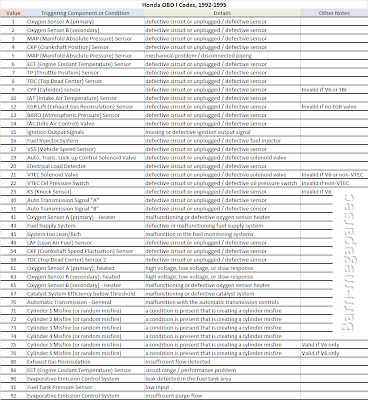The precursor to OBD II was, quite predictably, OBD I. It wasn't around for very long, and it wasn't as reliable, and it wasn't as useful, since each manufacturer did whatever they felt fit for reading the trouble codes.
For Civic and CRX models between 1992 and 1995 model years, the OBD I system was in place. For Accords, it's probably the same (although I am unsure, not having worked with them). Honda's particular method of getting OBD I trouble codes is slightly more advanced than simply plugging in a scanner.
- Pull up the carpet in the passenger footwell, around the right side (near the door).
- Notice on the right side: There is a jumper with at least two slots into which a wire can be inserted. With the ignition key in the OFF position, insert a wire or paper clip between these leads to jump it.
- Flick the key into the ON position, but do not crank the engine.
- If a status light flashes once very quickly, that is 1.
- If a status light flashes once for a longer period of time, that is 10.
- When the same status light turns off for a extended pause, it's done. Add the numbers together.
- It will repeat continuously, so if you missed it, just wait for the pause to end, and it will start over. If you have multiple codes, there will be a pause between each new code. Make sure you get all of them.
Hopefully this helps if you are in a situation similar to mine. I just had to learn this procedure a few days ago when my 1995 Honda's engine idiot light came on. I noticed that the engine would sometimes hesitate, so I wanted to figure out what was wrong as soon as possible. A friend referred me to the method for evaluating these codes. It threw me code 41: primary O2 sensor heater. So I turned to my Haynes manual and it told me to check it by disconnecting the output of the O2 sensor and checking the voltage across two of the terminals (check your service manual for detailed information about your vehicle), expecting about 0.9 V when warmed up, instead it read 0.04 V steadily, from cold to hot. Clearly the part was broken.
This is a very easy fix since the primary O2 sensor is right in the exhaust manifold up front, well within reach as long as you have the correct socket (which I borrowed from another friend, but if you want one, they can be found at Carquest for about $16.99). I replaced the primary O2 sensor, reset the battery, and the light did not come back on. When test driving it, it felt better. The problem was solved because the OBD let me know exactly what the problem was without having any detailed knowledge of the engine electrical system.
OBD I has two main advantages that make it pretty nifty for a shadetree mechanic.
- It doesn't need a scanner. So if you know how to do it, you can run codes yourself at home without buying any equipment. This means you can do true home maintenance with as little outside support as possible.
- It's less troublesome (No experience here, but I'm told this by reliable friends) if you want to modify your car. OBD II is considered to be more invasive and troublesome if you want to work on your engine in ways the manufacturer did not originally intend.
- The placement of the "port" is specific to certain vehicles. Not every one is the same. Because OBD II easily consolidated all the different systems, there was no reason to make mechanics learn something new that was manufacturer-specific. A better solution was possible, and quickly found.
- Customers balked at receiving diagnostic fees for simply having their codes read. Some unscrupulous dealers and other shops have billed customers for "dashboard disassembly" as part of the diagnostic fee, which vastly overstates the difficulty and time required to locate the port and read the codes, but customers may not have known any better, and it was at a point in time in which reading codes was novel, and the only alternative was a detailed physical inspection to learn the same secret.
- OBD II scanners provide more detailed trouble codes, and have more codes available.
- Adding up the codes by pencil and paper or memory is not hard, but if you're doing it 50 times a day, the extra time adds up.

Barn-Megaparsec: Basic: How To Read Honda Obd I Codes >>>>> Download Now
ReplyDelete>>>>> Download Full
Barn-Megaparsec: Basic: How To Read Honda Obd I Codes >>>>> Download LINK
>>>>> Download Now
Barn-Megaparsec: Basic: How To Read Honda Obd I Codes >>>>> Download Full
>>>>> Download LINK